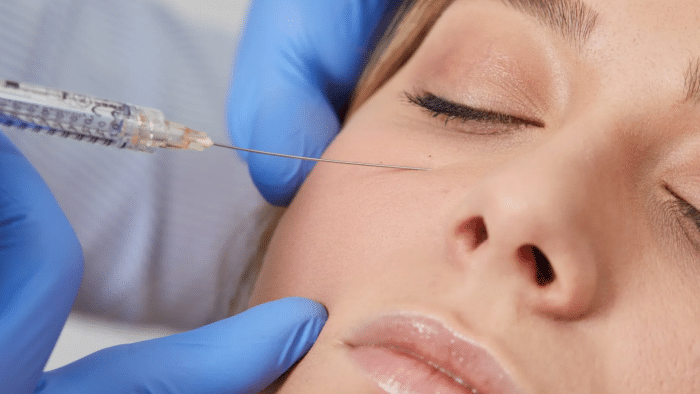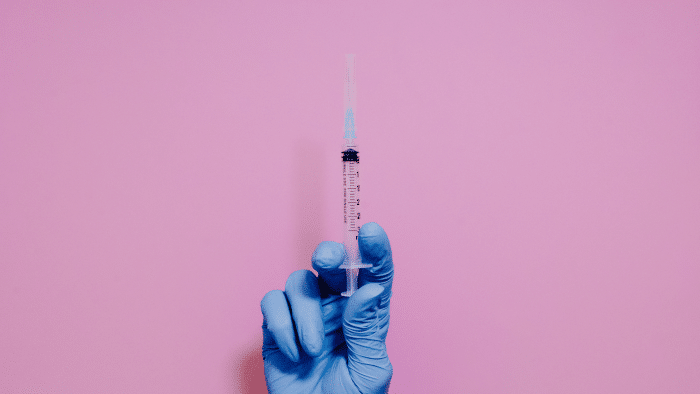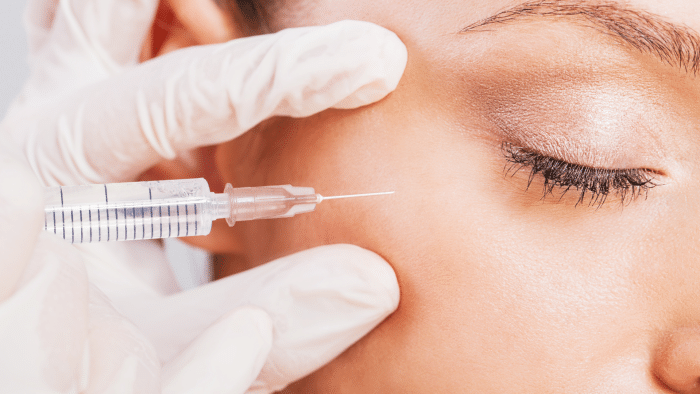
According to a systematic review, most patients who get nonsurgical tear through volumization using injectable fillers are highly satisfied with the short-term and long-term results. These findings explain why tear trough procedures are one of the fastest-growing cosmetic treatments.
Juvederm is a popular hyaluronic acid-based dermal filler that effectively treats tear troughs. As a professional injects Juvederm into the hollows beneath the eyes, it plumps the area, reduces shadows, and improves skin texture to resolve the signs of aging and fatigue. Its minimally invasive nature makes it an attractive option for those seeking natural-looking results.
In this article, we will explore the Juvederm tear trough procedure and discuss the expected results so prospective patients know how Juvederm can enhance their appearance and boost their confidence.
Key Takeaways
- Juvederm tear trough fillers are a non-surgical option to fix under-eye hollows and dark circles, making your face look refreshed.
- Doctors use special skills to inject the filler, avoiding too much volume for natural-looking results. They aim for precise placement to prevent lumps and ensure comfort.
- The treatment results can be seen immediately and last up to 12 months, with some products lasting even longer. Regular touch-ups maintain the improvements.
- Patients often have minor side effects like swelling or bruising, which improve in a few days. Serious problems are rare but need quick action.
- The ideal candidate has good skin quality and realistic expectations about the treatment.
Introduction to Juvederm Tear Trough Treatment

Tear trough concerns often include eye bags, dark circles, sunken eyes, and other lower eyelid worries. These issues can give the face a tired or aged look. A tear trough deformity makes the area under the eyes appear hollow and cast shadows over the lower eyelid.
Juvederm fillers are a type of cosmetic treatment made from hyaluronic acid. They help fix signs of aging on the face. For example, they can add volume to cheeks or smooth out wrinkles and lines.
Unique Challenges of Treating the Tear Trough Area
- Hollowing and Volume Loss: Hollowing and volume loss in the tear trough area create a sunken look around the eyes, creating shadows on the lower eyelid. These changes can make people look sad or tired as they age.
- Dark Circles and Discoloration: Dark circles and discoloration under the eyes make people look tired or older. This can happen due to a tear trough deformity, where a dark shadow falls over the lower eyelid. Treating this with injections, such as Juvederm, helps lessen the hollowness and reduce the appearance of these dark circles.
- Fine Lines and Wrinkles: These tiny lines can make people look tired or older than they are. Juvederm fillers play a significant role here.
Properties of Juvederm Fillers for Tear Trough Rejuvenation

The undereye area is delicate and needs a special touch. Juvederm fillers are crafted with VyCross technology, providing a thin and smooth consistency that is perfect for this sensitive spot.
Juvederm fillers blend into the skin, offering a subtle enhancement that looks and feels natural. Patients see a visible reduction in under-eye hollows, contributing to a more rested and youthful appearance.
It is crucial to focus on how long these outcomes will last, moving from the natural-looking results. Juvederm fillers are impressively durable. They can keep the under-eye area smooth and full for up to 12 months.
Injection Techniques for Juvederm Tear Trough Treatment
Precise placement in Juvederm tear through treatment is critical. The injector must place the filler exactly where needed to avoid lumps and unevenness.
Injecting Juvederm in the tear trough must be done with care. The goal is a natural look. More filler can make things look better, not better. That’s why doctors use a careful approach, adding just enough filler.
Doctors can apply ice packs to the treated area, which helps with swelling, bruising, and pain. Numbing agents also ensure patients feel comfortable during the injection or when the filler is adjusted.
Dosing Considerations for Juvederm Tear Trough Treatment

Every patient is unique, so their Juvederm tear trough treatment should be, too. Tailoring the approach to fit each person’s specific anatomy ensures the best results and helps avoid a possible allergy to Juvederm. It’s essential to look at each face differently—what works for one might not work for another.
Doctors must clearly explain to patients what Juvederm can do in the tear-trough area. Patients should understand that results vary and may need improvement on the first try.
It’s crucial to plan the treatment well to avoid injecting too much filler. The right amount depends on each person’s needs. This process keeps the look natural and prevents any unwanted effects.
Patient Selection Criteria for Optimal Juvederm Tear Trough Results

Good skin quality and elasticity are critical to Juvederm Tear Trough’s success. Doctors first check the skin’s ability to bounce back after being stretched, which helps them predict how well the treatment will work.
Patients who come in for tear trough treatments have unique needs and goals. They seek a nonsurgical way to correct issues like hollowing under the eyes or dark circles, hoping for natural-looking results that make them look refreshed and younger.
Knowing what patients hope for helps set the stage for managing realistic outcomes. Good skin tone and minimal excess are critical traits of ideal candidates. This process highlights how not everyone will be a perfect match for tear-through filler treatments.
Expected Results and Recovery from Juvederm Tear Trough Treatment

After getting Juvederm treatment, people notice a significant change in their tear trough area. This filler works fast to fix hollows under the eyes, making you look refreshed. Undereye bags and dark circles improve quickly.
Juvederm Tear Trough treatment offers long-lasting effects. Most patients see their results lasting about a year. For ongoing benefits, they return for maintenance treatments every six months to one year.
Swelling, bruising, redness, and soreness are joint after tear-through treatment with Juvederm fillers. These side effects usually get better within 48 to 72 hours. Patients should use cold compresses to manage them and keep their heads elevated.
Conclusion
Juvederm fillers effectively address tear trough concerns, providing natural-looking results and long-lasting improvement in hollowing, dark circles, and fine lines. Medical professionals can optimize outcomes and enhance patient satisfaction with Juvederm tear trough treatment by understanding the unique challenges of treating the delicate under-eye area and employing tailored injection techniques, dosing considerations, and patient selection criteria.
Effective communication, realistic expectations, and post-treatment care are essential to achieving successful results and empowering patients to feel confident in their appearance.
FAQs
1. What is a Juvederm tear trough treatment?
It’s a quick procedure where they put filler under your eyes to make you look less tired.
2. Does getting Juvederm in the tear trough hurt?
You might feel a little pinch, but they use numbing cream to make it more comfortable.
3. How long does it take to see results after the treatment?
You’ll notice a difference immediately, but after a few weeks, the total effect shines through.
4. Are there any side effects I should know about?
Some people might get swelling or bruising, but it usually disappears quickly.
5. How long does Juvederm last in the tear troughs?
The smooth look can last up to a year before you want another visit.
References
Gorbea, E., Kidwai, S., & Rosenberg, J. (2021). Nonsurgical Tear Trough Volumization: A Systematic Review of Patient Satisfaction. Aesthetic Surgery Journal, 41(8), NP1053–NP1060. https://doi.org/10.1093/asj/sjab116
Sharad J. (2012). Dermal Fillers for the Treatment of Tear Trough Deformity: A Review of Anatomy, Treatment Techniques, and their Outcomes. Journal of cutaneous and aesthetic surgery, 5(4), 229–238. https://doi.org/10.4103/0974-2077.104910
Funt, D., & Pavicic, T. (2013). Dermal fillers in aesthetics: an overview of adverse events and treatment approaches. Clinical, cosmetic and investigational dermatology, 6, 295–316. https://doi.org/10.2147/CCID.S50546
Related Articles
Joanna Carr
Juvederm vs Kysse: Comparing Hyaluronic Acid Fillers
Juvederm and Restylane Kysse are both hyaluronic acid fillers used for lip enhancement. Read more in this in-depth comparsion.
Joanna Carr
Sculptra For Buttocks – A Non-Surgical Lift
Achieve a fuller, lifted look with Sculptra for buttocks. Discover how this non-surgical option enhances curves and boosts volume naturally.
Joanna Carr
What Is Osteoarthritis (Arthritis)? Causes And Treatment Review
Interested to learn more about What Is Osteoarthritis? Reviewing Causes And Treatment? Browse Doctor Medica's comprehensive listing of blog posts.


